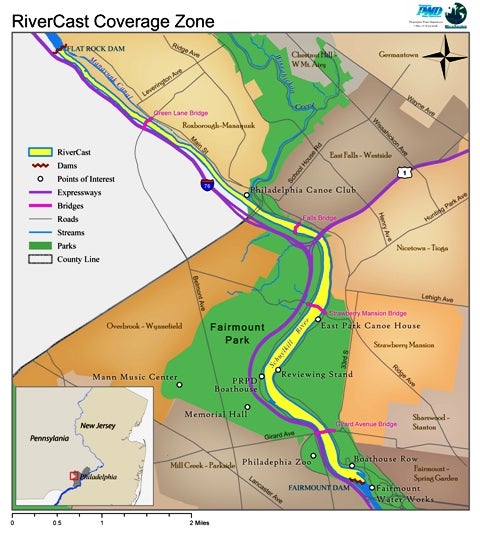Rivercast tracks Schuylkill River quality

By Kellie Patrick
For PlanPhilly
Thanks to a Philadelphia Water Department website, you can find out how safe the water is before you head out the door. And in the future, river users will be able to get the same information for the Delaware – and maybe even find out if the fish are biting.
The site, called Rivercast, can be found at www.phillyrivercast.org.
Water Department Manager of Watershed Science and Engineering Chris Crockett created the site in his spare time and manages it “for fun.”
“We would get calls. ‘Is it safe to swim in the river? We’re having the X Games. We are rowing, and we plan to throw the coxswain in the water when we win,’” Crockett said. His favorite calls came from people who were making films: “ ‘We’re filming tomorrow at 8 a.m. What will the bacteria level in the river be? We’re doing stunts. Is it safe to be in the water?’ No agency – state, federal or local, would tell them that.’”
The Schuylkill, Crockett said, was suffering from a dirty river stigma. Other rivers that are less clean were less feared.
Until June 2005, Crockett didn’t have a good way to predict water quality. But he did offer this rule of thumb: “When it’s brown, don’t go down. If it’s green, it’s pretty clean.”
The river tends to look “like chocolate milk” after a storm, and that’s also when the water is likely to have unhealthy levels of bacteria, Crockett said.
The brown in the water isn’t itself the problem — it’s just mud. The water gets churned up and muddy because of all the runoff coming into the river from upstream, he said. The runoff contains animal waste from agricultural areas and sometimes, if the storm is big enough to overwhelm sewer systems, it can contain human waste.
The river gets clean again in about 48 hours. And when things settle down, algae give the river a greenish tint.
Then in 2005, Crockett got a $50,000 grant from the Environmental Protection Agency to create a system that would predict water quality and Rivercast was born.
The water department had gobs of data – it constantly takes measurements of water temperature, the amount of rain that has fallen, and the cloudiness of the water. And it collects samples for testing in the part of the river between Fairmont Dam and Flatrock.
The problem was that it takes 48 hours to incubate a sample for bacteria testing, so there was no way to give a daily bacteria reading.
But with all the data collected over the years, Crockett could trace the pattern – he could see what other conditions coincided with high bacteria levels. With that information, he created a computer algorithm that predicts the level of harmful bacteria based on the other factors.
“It’s updated every hour … the equipment measures conditions every minute,” Crockett said.
What Rivercast predicts is the amount of e coli and fecal coli form present, Crockett said. The presence of these bacteria indicates the presence of other pathogen nastiness, he said, including parasites like giardia and viruses like Norwalk.
The system can also be manually set to red – as it was last June after a Merck research facility released a form of cyanide into the sewer system.
About 70,000 viewers have checked out Rivercast since it went live – without any advertising. “It was the first of its kind in the country,” Crockett said. Kayakers and waterskiers use it, as do people who fish – fish activity can be correlated with water temperature.
Many have written to ask Crockett to supply more data – you can email him through the website.
“People are calling me from all over asking if I could have the same information for the Delaware,” he said.
By next summer, Crockett wants to provide information about the lower portion of the Schuylkill –the tidal portion from Fairmont down to Port Mifflin.
He has also planned to set up a system for the Delaware River by the following year – 2009. The same data that is used to for Rivercast’s Schuylkill predictions is available for the Delaware in the north east part of the city, at the Baxter Water Treatment Plant. And Crockett would also like to provide information for people who use the section of that river from Northern Liberties to the Navy Yard.
But it would be unwise to assume the same factors that indicate water quality for the Schuylkill would work for the Delaware – or that samples collected from the Baxter plant would apply to a site so far downstream as the Navy Yard. So more research will have to be done, Crockett said.
Crockett has been advising those working on the river pool project. The Rivercast expansion could be fast-tracked if it was needed for a pool and money was available, he said.
In addition to expanding the coverage area, Crockett would like to expand Rivercast’s scope.
Kayakers would like a “rowability” conditions report that would alert them to things like logs in the water, he said.
People who fish – including Crockett himself – would like a red, yellow and green rating for how much the fish are biting that day and information on what kind of fish are around.
All of this would be possible, he said – with the right data.
.
WHYY is your source for fact-based, in-depth journalism and information. As a nonprofit organization, we rely on financial support from readers like you. Please give today.






